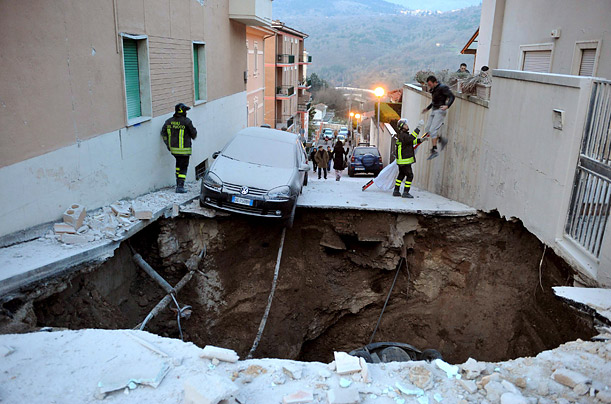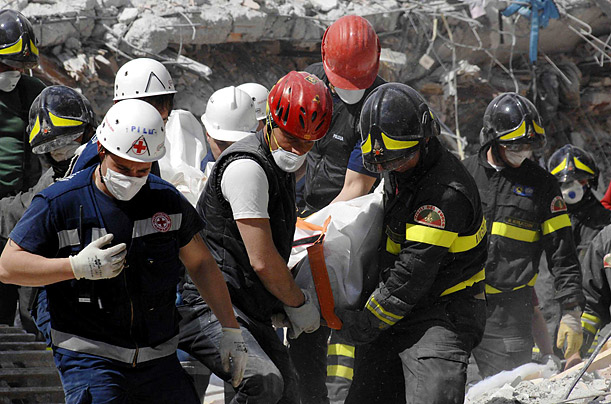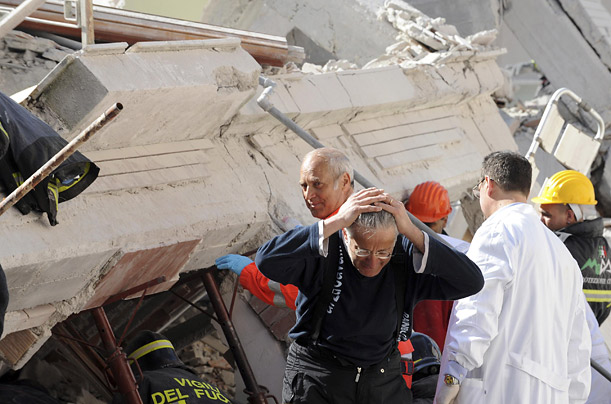Introduction
There are a few natural processes that can be as scary as an earthquake. A human can brace for typhoons by staying indoors. A well-constructed house can withstand normal typhoons. Flooding can be defeated by planning and create mechanisms that will limit the rapid collection of water in cities and other populated areas. Forest fires can be overcome with a well-trained crew of firefighters. But the best system in the world and the best organization on the planet could never defeat an earthquake.
This is because earthquakes can come suddenly and without warning come with such destructive force, it can easily level a city. A high magnitude earthquake shook Central Italy and the worst hit was the city of Aquila. In the aftermath the pain and sorrow were palpable but it did not take long before the people decided to move on. They continued to grieve for dead loved ones but at the same time, they demanded that the government make a serious attempt to increase “earthquake safety” in Italy.
Terrible Quake
There is one phrase that is used to express trepidation and the one expressing it will say that he is quaking in fear. This phrase goes to show the terrifying prospect of being caught in the middle of an earthshaking calamity. The same fear was felt by the residents of Aquila, Italy when a 6.3 magnitude earthquake did not only shatter the peace of dawn but also laid many Italians to rest in eternity. Moreover, the tremor destroyed old buildings the damage that resulted from the violent shaking of the earth could not only be measured by financial ruin alone for this is a historic city in the middle of a very important country.
The fear generated by an earthquake is linked to its sudden occurrence. There are no warning signs. The best and the brightest, together with their numerous college degrees as well as their slick instruments are no match for the invisible force of an earthquake. For centuries many had tried to develop a way to predict earthquakes but so far no one had succeeded to come close with even a basic early warning device. This could be due to the sheer size of the earth’s tectonic plates. It could also be because no one can track down all the moving objects beneath the earth’s surface. No instrument can measure magma and account for the planet’s tectonic plates.
A forest fire though it is destructive can be tamed and even prevented. A knowledgeable team of professionals can reduce the risk of a forest fire by performing the necessary task of removing highly combustible materials in the forest. Even if there are a few qualified people with the high level of expertise needed to prevent forest fires, a well-equipped fire fighting force can be called upon to put down minor fires before they can escalate into catastrophic levels. Forest fires still occur regardless of prevention efforts but still one can argue that they can be prevented. It is not too often that forest fires figure in news headlines. This can be the proof that it can be managed or at least it is possible to mitigate the risk.
Typhoons are also as deadly as forest fires and as destructive as an earthquake. Winds moving at high velocity can easily destroy huge structures, damage vehicles, and at the same time bring in heavy volumes of rainwater that can even cause more devastation even if the winds had already died down. After a city has been battered with cyclonic winds the water brought in by a superstorm will remain for days or even weeks and the health problems brought upon by flooded streets can easily raise the casualty rate.
While cyclones are very destructive and while floodwater can easily upset the normal routine of individuals the aforementioned natural phenomenon can be detected far in advance. It is very possible to know the movement of strong winds days before landfall. There is enough time to warn residents and if needed there is time to evacuate the people and move them into a much safer place. An ordinary typhoon may carry strong winds but modern houses and well-constructed buildings can easily handle the impact of howling winds.
While there is ample time to prepare and counter the effect of typhoons and forest fires, there is still no equipment or method of analysis that can help predict earthquakes. If there was then the casualties of the Aquila quake would still be living right now and able to enjoy the company of loved ones. But the bitter truth is that the best scientists can do is to engage in scientific guesswork but no one can claim with certainty that they can predict the next big seismic activity. The family of the victims of the Aquila quake knew this for a fact but it was still hard to accept that someone’s daughter, son, father, or mother was buried under thick rubble.

Another major problem when it comes to increasing the level of preparedness against earthquakes is that there seems to be no logical defense against them. Going back to the analogy of typhoons and other natural disasters one will realize that to survive natural calamities the defenses that are put up are anchored on the earth. For instance, buildings that are used as shelters, man-made structures that people will use for protection from a heavy downpour, or even a tornado are constructed using the ground as a foundation. But what will happen if the ground moves? This is the dilemma when it comes to figuring out how to defeat an earthquake.
Gravity pulls every organic and inorganic thing towards the earth. Unless man figures out a way to fly there is no escaping the earth’s grasp. Man will forever be a terrestrial being and it has to come to terms with earthquakes. If it cannot be predicted then technology must be improved to make houses and public buildings earthquake-proof. There must be a way to minimize damage and there must be strategies that can be used to increase the level of safety in homes. Former victims of earthquakes must not forever cower in fear in anxious anticipation for the next big one.
Social Impact
The death toll rose to as high as 235 (Donadio & Povoledo, par. 1). The quake did not discriminate between young, old, and very young. It did not discriminate between father, mother, and child. Some students were buried under collapsed buildings, there were old women crushed under broken homes. There were at least 17,000 people who were left homeless (Donadio & Povoledo, par. 12). Countless people will remain emotionally scarred for the rest of their lives.
Property damage is difficult to assess. One is not merely talking about subsidized government housing or new buildings that were constructed a few years ago. This is the region where history books as well as countless novels use for their setting. This is a place where one can find buildings that were constructed hundreds of years before the creation of the United States of America. That goes to show how priceless are building that was damaged by the tremor a few weeks ago.

In a normal earthquake tragedy, there are only three things that are of primary concern:
- the number of casualties and injured;
- the magnitude of the earthquake that registered on the Richter scale and
- property damage.
In the case of the Aquila quake, there are other aspects of the tragedy that requires in-depth analysis forcing the reader to ask for more than the usual statistical information. First of all the epicenter of the earthquake is relatively close to the Vatican, a sacred place for close to a billion people all over the world. Secondly, Central Italy is full of historical landmarks, old buildings and played a significant part in the shaping of European history (Donadio & Povoledo, par. 1). Finally, the magnitude of the quake is a mere 6.3; still strong but it should not have leveled a city belonging to one of the richest nations in the world.
When an earthquake hits the first question is location. Where did it occur? The urgency of the question is due to concern that one may know someone living at ground zero. If the quake happened far away one can offer prayers for the victims but after a brief pause, the tragedy is quickly forgotten, especially if no known relative or friend lives or work in the said area. This time around strangers have every reason to be a concern because the epicenter of the tremor was very close to the Vatican, the official residence of the Pope, the most revered man in the whole of Christendom.
Aside from the safety of the Pope, his cardinals, the numerous priests living in Rome there is also great fear that the most treasured architecture and artifacts as far as Roman Catholics are concerned will be buried from the recent seismic activity. This is the reason why the earthquake last April of 2009 was felt and heard all over the world. This is also the reason why there was an overwhelming outpouring of support. Even the newly elected President Obama offered to help preserve the region’s cultural and artistic heritage (Donadio & Povoledo, par. 9).
The spotlight was focused on the faith of the people not only because of the location of the earthquake but also because the tragedy happened days before Easter, one of the most important days for Christians all over the world. For this reason, “The Vatican granted a special dispensation to hold a Mass on Good Friday, the only day on the Roman Catholic Calendar on which Mass is not normally celebrated (Gera & David, par. 5). If there is any consolation it is the realization that they have the Pope to urge them not to give up hope (Gera & David, par. 1).
There is no price tag for human life and the more than 200 people who died will be missed terribly by family and friends alike. But there is also the issue of the homeless. If the money that was supposed to be invested in ensuring that buildings pass seismic standards the cost of housing and taking care of thousands of homeless people would have been much less. Still, this is not the time to count the monetary cost of helping the victims. There is a need to help especially the kind that will give the victims and the survivors the ability to cope. Italy will never experience rest from significant seismic activity. It is located in two major fault lines and this is the reason why from time to time Italy will experience deadly tremors. This is now the time to look into the future and do everything that they can to prevent this tragedy from occurring again.
Safety First
In the aftermath of the tragedy, many were still dazed and numb with fear. Occasional but powerful aftershocks will deny the residents of Aquila the rest that they so needed. While many are still grieving the whole nation is asking the question as to why a 6.3 quake can do so much damage. It was already mentioned before that this type of intensity can cause serious damage but not this kind of damage. There is also the complaint that this is one of the richest nations on this planet so there should be an explanation why even modern buildings were not spared from the quake while other structures remained unscathed.

Some are upset because this is not the first time that a high magnitude quake devastated Italy. In 1980 2,500 people were killed after a massive tremor hit the southern town of Irpinia and in 2002 an earthquake measuring a mere 5.5 on the Richter scale brought down an elementary school in the southern Molise region (Israel, par. 7). This means that the government is not investing in technology that could easily prevent buildings from caving in. Some pointed out the irony that Italy is a member of the G8, the association of highly industrialized nations in the planet to which the U.S. and UK belong (Israeli, par. 7).
It is easy to understand if there will be a lot of finger-pointing. But the main reason why this problem was not taken care of a long time ago was summarized by one resident who said, “There is a chronic incapacity of Italian leaders to think in the long term, or even beyond the next election. To invest in proper seismic standards doesn’t get you votes” (Israeli, par. 9). The observation cuts to the bone of Italian politics but as mentioned earlier other factors made it difficult or even practical to pour huge sums of money over a project that will not guarantee solid results. Still, the number of dead Italians, as well as the 17,000 homeless people, will now force Italian leaders to do much more than offer their condolences.
Conclusion
Indeed there is nothing as destructive as an earthquake. It comes suddenly and sometimes it comes in the middle of the night when children are fast asleep. On other occasions, it comes when parents are away and helpless to rush in to save their children or pluck them out from the debris that engulfed them. Earthquakes are unpredictable, providing no warning but when it arrives it comes with a fury that can knock huge man-made structures. Everyone can prepare for floods, storms, and even fires but there is no way that one can be one hundred percent prepared for an earthquake.
The best that could be done is to develop structures that can withstand the impact of a high-intensity quake. This realization came too late for many Italians who died last April. Many are blaming the government for its failure to prepare for this day of reckoning. Many agree with them because Italy is a G8 country, one of the richest nations in the world and it is a shame that they could not prepare for an earthquake the measured just 6.3 on the Richter scale. Truly a 6.3 seismic activity can readily do damage but not the kind of devastation experienced in Aquila and not in the 21st century.
Works Cited
Donadio, Rachel & Elisabetta Povoledo. “Rescuers Scramble in Search for Quake Survivors.” Web.
Gera, Vanessa & Ariel David. “Pope Urges Quake Survivors to Keep Up Hope.” 2009. Time Magazine Archives. Web.
Israely, Jeff. “Italy Buries Its Dead and Questions Earthquake Safety.”
TimeMagazines Archive. Web.